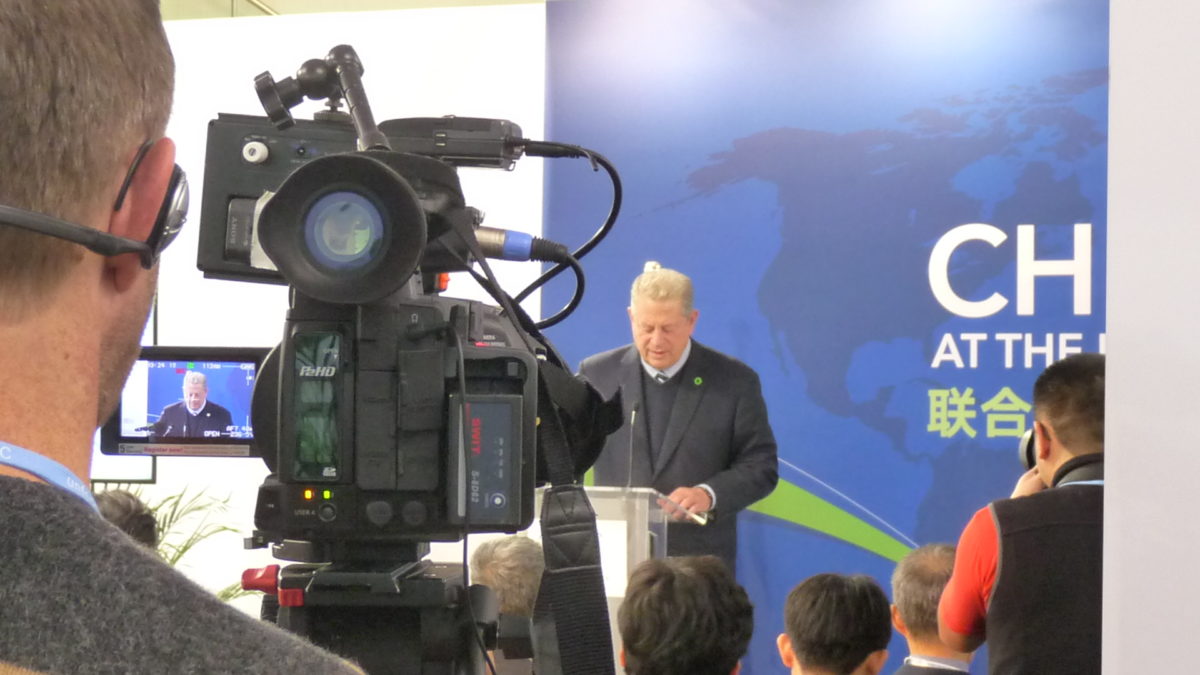From pv magazine, January edition.
By stark contrast to the presence of the host nation’s ‘clean coal’ and natural gas pavilions – which enjoyed pride of place at the entrance to the public exhibition area, away from the plenary rooms where the real business was being conducted – there was no visible stand devoted to solar power.
It was a juxtaposition, or rather lack of one, that was partially cloaked by the understandable indignation of delegates attending a conference that was entirely centered on the need to keep fossil fuels in the ground. But the lack of industry presence did not go unremarked by all of the COP24 meeting’s reported 20,000 visitors.
Nils Røkke is chairperson of the European Energy Research Alliance (EERA) and, as a visitor to previous COP meetings held annually by the UN’s Framework Convention on Climate Change, he noted the lack of visibility from the solar sector, as well as other established clean energy technologies.
“I’m not sure if the industry… they’re not here really,” said Røkke, at the end of another day trying to impress upon politicians the importance of coordinating EU clean energy research and development under one organization. “I think [COP] is seen as too theoretical. We don’t see the huge manufacturers around here, with the huge displays. You used to see that before, for instance in Copenhagen. There’s more space for the NGOs and the politicians.
“I think [the PV industry] should be [here]. [They are] the people that are going to make this happen, to make these gadgets which you need in the field, so their voice should be better heard in these sorts of negotiations.”
Seeing the wood for the trees
Photovoltaics, of course, were mentioned in numerous presentations over the course of the week that pv magazine was in attendance in Katowice, and presumably during the preceding week’s sessions as well. But Røkke said he feared the tortuous negotiations over a rulebook to implement the pledges made at the Paris COP three years earlier risked losing touch with the technologies which reducing greenhouse gas emissions will need.
“You don’t see much advertising about [PV] here,” he added. “But you don’t find so much technology here – the people who are pushing the technology are not really here. Where are the wind people here? There are hardly any.
“I was speaking to our minister for environment, Ola Evestuen, who is part of [Norway’s] negotiations [team], and I said, ‘[Is] anybody talking about what you are going to do to reach these targets, with technologies, you know?’ The answer is really ‘no’.
“We are talking about how much can you do? How much can you take? What can you do? About sharing [responsibility for emissions reductions]. [Also, we are discussing] what words should we use? Are we going to save ‘the world’ or ‘the planet,’ things like that – ‘Mother Earth’ cannot be used because it’s too sentimental. And that worries me, because there’s a complete detachment, obviously, from the technology here, like PV and [asking] ‘okay, what can PV contribute?’ Obviously, there will be tremendous changes in how we can produce our electricity, decarbonize the electricity supply and bring people out of poverty and so forth.”
U.K. developer Proinso was the only dedicated solar company pv magazine saw presenting in the Katowice venue, and the desperately thin attendance perhaps gave an insight into why that was. Perhaps solar’s enormous success has taken it mainstream, to the point where policymakers and journalists alike feel they know all they need to about its benefits. Though the industry’s increasingly active R&D sector gives the lie to such assumptions, Proinso’s head of marketing and communications – Masa Njegovan – put a positive spin on the attendance for her talk, and said it was proof the industry has been successful in sending out a positive message.
The outlook for China
“I think at an event like this we cannot really expect them to focus on a single source of energy,” she said. “For them it’s rather, a policy that will determine the percentage of renewables as a mix that will contribute towards the total energy generation mix.
“I wouldn’t say it’s surprising that solar is not a key message, but on the other hand I would say although it might not be a key topic of main presentations, I have seen quite often – in very strategic presentations where they talk about renewables – they emphasize that solar is perhaps taking a leading role, and taking a leading role versus wind as well. So I can say that when they talk about it, they don’t mention hydro in this perspective.
“They mention solar and wind and they obviously make very strong remarks in terms of solar taking a dominant role in the future. I would say there’s been an increased focus on the solar industry, although maybe it’s not as well articulated as we would like – [by] us in the solar industry.
“Obviously we’ve seen the biggest cost decline over the last 10 years, I think it’s probably one of the most efficient energy sources nowadays, even among the technologies that we currently have, and probably the cheapest one globally, so I do believe that in the future solar will take a leading role. I definitely do.”
If solar was keeping a relatively low profile – a PV advocate was the only member missing from a REN Alliance panel considering a report into a fully renewable-driven energy system in Europe by 2050, for instance – there were two pavilions where the sun still shone.
The Chinese stand attracted a big crowd on the meeting’s final day as the latest China Renewable Energy Outlook (CREO) report was presented. With government representative Xie Zhenhua having revealed 24 hours earlier that his nation’s below-2 degrees Celsius global temperature rise ambition would see the creation of 69 million jobs, CREO’s findings brought further attention-grabbing stats, including a prediction that solar would be providing 23% of the nation’s energy by 2050.
Indian rooftops
That was enough to prompt Zhongying Wang to call for the solar giant’s renewable energy ambition to be formally adopted into China’s 45-year plan.
The importance of Chinese PV was emphasized by the pavilion’s coup in securing a presentation from Al Gore – with the U.S. politician by some distance the biggest draw in Katowice. The charismatic emissions reduction champion had preached to a rapt audience in the largest section of the sprawling COP venue 24 hours earlier, and drew a similarly enthusiastic response when he predicted it would be the U.S. – with a new occupant in the White House – and China that would lead the global energy transition.
In the nearby India pavilion too, solar drew the crowds – a phenomenon that became more marked when a presentation about climate policy, which had no direct reference to solar, attracted an unusually poor turnout. In India, solar is an established business and with ground-mount making huge strides, Rupin Dushyant Patel, Associate VP of Tata Cleantech Capital Ltd, said it was time for rooftop solar to follow in its footsteps, even if he was forced to admit the current government target may be too ambitious.
“The rooftop [capacity] currently in India is around 3.4-3.5 GW and really that’s a very small part of the high capacity that we have,” said Patel. “Between wind and solar the current [installed capacity] would be close to 75 GW. So the point I was making was, it is less than 5% right now, so therefore we’ve barely scratched the surface as far as rooftop solar is concerned. India has an ambitious target of reaching 175 GW of renewable energy capacity by 2022, which is a much talked about figure. Out of this 175 GW figure, 40 GW is targeted at rooftop solar. So currently we are [looking] at a very small but nascent sector. Also, at the moment it is picking up because out of that 3.5 GW, close to 1.5 GW have been installed in the last 12 months. So month-on-month, the momentum is picking up, but on the current trend it could possibly be a stretch [to reach 40 GW by 2022].
PV as a community addiction
“Possibly we may achieve around 15-20 GW but even then, that’s a significant increase on the current 3.5 GW in the next three to four years. For the figures I was mentioning, the potential is large. We’re just at the initial stage of the sector. We’ve been working on trying to determine bankable solutions for facilitating [the] flow of capital into this sector and so therefore, yes, we do see this sector really scaling up. We do see it as a key engine, one of the natural engines of growth as far as increasing the [installed renewable] capacity is concerned. We start from a very small base but, you know, when you scale some, we can make a significant contribution in meeting our 175 GW capacity.”
Even the revelation made by Anand Kumar, secretary of the Ministry for New and Renewable Energy, that the Indian government is preparing to apply customs duties on batteries in an attempt to attract manufacturers to south Asia, failed to burst the bubble of solar optimism in the Indian corner of the vast venue.
The popular appeal of small-scale solar was further demonstrated by a panel discussion in the EU pavilion about the merits of energy cooperatives.
Julien Guerrier, executive director of the European Executive Agency for Small and Medium-sized Enterprises, explained such groups had prompted
33 MW of small-scale PV in the Spanish farming community, and said half of Europe’s citizens could be generating renewable energy by 2050. Fellow member of the panel Dirk Vansintjan went further, predicting 83% of the EU populace could be participating in the energy transition by that stage if you throw in demand response and energy storage as well.
And it was Vansintjan who best summed up PV’s irresistible appeal – regardless of how many tents it pitched in the heart of Poland’s coalmining region – when he described solar power as: “a gateway drug into the energy transition”.
This content is protected by copyright and may not be reused. If you want to cooperate with us and would like to reuse some of our content, please contact: editors@pv-magazine.com.




By submitting this form you agree to pv magazine using your data for the purposes of publishing your comment.
Your personal data will only be disclosed or otherwise transmitted to third parties for the purposes of spam filtering or if this is necessary for technical maintenance of the website. Any other transfer to third parties will not take place unless this is justified on the basis of applicable data protection regulations or if pv magazine is legally obliged to do so.
You may revoke this consent at any time with effect for the future, in which case your personal data will be deleted immediately. Otherwise, your data will be deleted if pv magazine has processed your request or the purpose of data storage is fulfilled.
Further information on data privacy can be found in our Data Protection Policy.